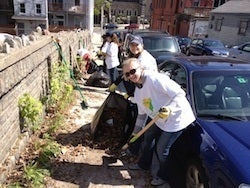April 27, 2012
The Harvard School of Public Health (HSPH) community marked Earth Week 2012 with a wide variety of activities, ranging from a talk on “handprinting” (the opposite of “footprinting”) to a neighborhood clean-up.
In an April 27, 2012 talk, HSPH adjunct lecturer and life cycle assessment expert [[Gregory Norris]] described how, instead of focusing only on our carbon “footprints,” we can also look at the flip side and estimate our “handprints”—our net positive impact on the planet, such as boosting human rights, improving literacy, or inspiring others to help improve for the planet.
Norris cited Al Gore’s activities as an example of how to estimate a person’s “handprint.” To spread the word about climate change, Gore takes numerous plane trips, which gives him a big carbon footprint. But if his talks convince others to take action to reduce carbon emissions, his net impact on the planet may be positive. “The bigger our footprint, the greater our obligation to do more with handprinting,” Norris said.
Norris developed a handprinter tool to help people calculate their positive impact. Recently, Time magazine listed his innovation as one of “10 Ideas That Are Changing Your Life.”
“The handprinter tool can show you what you can achieve,” Norris explained. “With enough handprints, we can heal the planet.”
Check out the handprinter tool
Other Earth Week activities included a Mission Hill neighborhood clean-up event; a mini-sustainability fair; a demonstration about urban beekeeping; a “Take the Stairs” campaign; book, CD, DVD, and clothing swaps; free bike tune-ups; and a talk on the relationship between sustainability, stress, and health—including a guided relaxation exercise—by Herbert Benson of Massachusetts General Hospital’s Benson-Henry Institute for Mind Body Medicine. Learn more about Earth Week 2012 activities, HSPH’s ongoing sustainability efforts, and green tips at the the Eco-Opportunity website.
–Karen Feldscher
Photo courtesy of Jen Doleva
